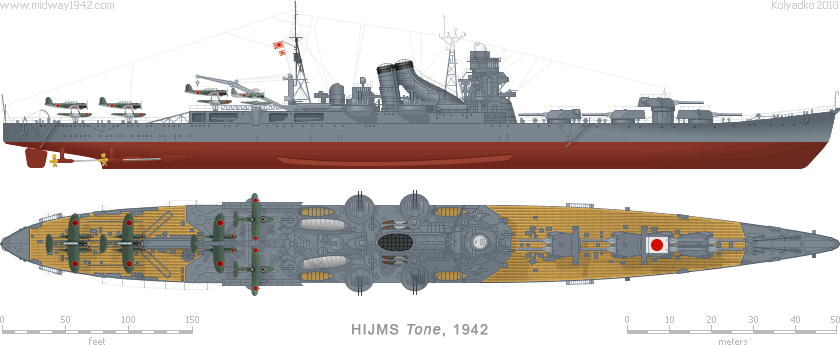
| Tone class, 利根型 | HEAVY CRUISERS, 重巡洋艦 | |

| Displacement: | 15,443 t (11,213 t Std) | Machinery: | 8 boilers, 4 shafts | Main Guns: | 4×2×8 in (203 mm)/60 | Main Belt: | 3.9 in | 100 mm | |||||||||
|---|---|---|---|---|---|---|---|---|---|---|---|---|---|---|---|---|---|
| Max Length: | 661 ft 5 in | 201.6 m | Max Power: | 152,000 hp | 111 796 kW | DP Guns: | 4×2× 5 in (127 mm)/40 | Decks: | 2.5-1.2 in | 65-30 mm | |||||||
| Beam: | 60 ft 8 in | 18.5 m | Max Speed: | 35 kts | 64.82 km/h | AA Guns: | 6×2× 0.98 in (25 mm) * | Barbettes: | 0.98 in | 343 mm | |||||||
| Draght: | 21 ft 4 in | 6.5 m | Range: | 12,000 nm | 22 224 km | Torpedoes: | 4×3×24 in (610 mm) tubes | Turrets: | 0.98 in | 25 mm | |||||||
| Complement: | 874 officers & enlisted | Bunkerage: | 2690 t fuel oil | Air Group: | 3× E13A1, 2× E8N2 * | CTower: | 5-2.75 in | 130-70 mm | |||||||||
** Antiaircraft armament and Air Group as during the Battle of Midway (June 1942).
Two Tone class cruisers were originally envisaged as the fifth and sixth vessels in the Mogami class, however, by the time construction began, weaknesses in the Mogami class design had become clear, and Japan no longer had any intention of even pretending to abide by the limitations of the London Naval Treaty. This resulted in a new design, which turned out to be quite different from the Mogami class, although external dimensions were very similar. Unique to the ships was the placement of their main armaments forward of the bridge, which left their quarter decks free for aircraft usage. The Tone class cruisers were intended to provide long-range air scouting for cruiser squadrons and to operate together with aircraft carrier task forces. Commissioned in 1938−1939 these ships became the last heavy cruisers produced for the Imperial Japanese Navy.
Tone and Chikuma operated together for almost all of their careers as consorts for aircraft carriers. The ships were part of the covering force during the attack on Pearl Harbor, the Second Battle of Wake Island, operations in the Netherlands East Indies, the Indian Ocean raids, the battles of the Eastern Solomons, Santa Cruz, Philippine Sea, and Leyte Gulf.
Both Tone class cruisers took part in the Battle of Midway as a Cruiser Division 8 allotted to First Air Fleet (First Mobile Force).
| Ship | Builder | Laid Down | Launched | Commisioned | Fate | |||||||||||||
|---|---|---|---|---|---|---|---|---|---|---|---|---|---|---|---|---|---|---|
| CA-17 利根 | Tone | Mitsubishi Shipyards, Nagasaki | 1 | Dec | 1934 | 21 | Nov | 1937 | 20 | Nov | 1938 | Sunk in action | 24 | Jul | 1945 | |||
| CA-18 筑摩 | Chikuma | Mitsubishi Shipyards, Nagasaki | 1 | Oct | 1935 | 19 | Mar | 1938 | 20 | May | 1939 | Sunk in action | 25 | Oct | 1944 | |||